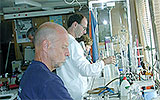Water Quality
To assess trends in water quality, the TransNational Monitoring Network of the ICPDR carefully monitors physical, chemical and biological conditions in the Danube and its major tributaries since 1996. The trans-national monitoring network (TNMN) for the Danube builds on national surface water monitoring networks, and consists of 79 monitoring stations.
Facts and figures (1996-2000)
As the Danube flows towards the Black Sea conditions in its waters change considerably. From the upper to the lower reaches of the Danube scientists have monitored significant overall increases in the following determinands:
- suspended solids
- organic pollution (expressed by COD)
- organochlorine pesticides (Lindane, DDT)
- concentrations of heavy metals (especially cadmium, and with the exception of manganese, for which the maxima were observed in the middle Danube)
- concentrations of nitrite and ammonium (however, the concentration of nitrate decreases)
- phosphorus (both total phosphorus, and phosphate)
- conductivity (caused by dissolved salts)
- alkalinity
Most tributaries contain higher concentrations of organic pollutants and nutrients than the Danube itself.
However the TNMN Yearbook 2001 clearly pointed out positive changes in the water quality in 2001 compared to the comparative assessment 1996-2000:
- Reductions in biodegradable organic pollution were visible in the Austrian and Slovakian stretches of the Danube, at Danube-Hercegszanto, and in the lower reaches of the river downstream of Danube Chiciu/Silistra.
- Less biodegradable organic pollution was also observed in tributaries including the Inn, Dyje, Drava, Arges and Siret.
- Ammonium concentrations had decreased in the upper part of the Danube all the way down to Danube Szob, and in the tributaries from the upper reaches down to the River Vah.
- Reductions in nitrate loads were observed at several stations in the German and Austrian parts of the river basin; at Danube-Szob; in the tributaries Morava, Dyje, Vah, Drava; and at Sava–us.Una Jasenovac.
- Phosphate concentrations had generally decreased along the joint Slovak–Hungarian section of the Danube, and in tributaries entering the upper Danube, as well as at Drava, at Siret, and at stations located on the River Sava at Sava–us.Una Jasenovac.
Did you know?
Clean enough to swim
It is generally safe to swim in the Danube, but local pollution hot spots downstream of big cities and the mouths of polluted tributaries should be avoided.
IAWD Good drinking water quality
The Danube is a drinking water source in many locations. According to an IAWD study programme conducted in 2001 and 2002 good water quality for drinking water purposes (without treatment) has only been achieved in the stretch of the Danube between Dettingen and Leipheim (Germany) and Mohacs (Hungary). However, oxygen levels of the Danube are high enough to allow treatment with natural processes, such as bank-filtering or slow sand filtration to reach drinking water quality.
Additional technical measures to maintain the drinking water standards are only necessary during extreme events including floods, incidents involving hazardous substances and insufficient wastewater purification.
Disclaimer
The information contained in the ICPDR website is intended to enhance public access to information about the ICPDR and the Danube River. The information is correct to the best of the knowledge of the ICPDR Secretariat. If errors are brought to our attention we will try to correct them.
The ICPDR, expert group members, nor other parties involved in preparation of information contained on this website cannot, however, be held responsible for the correctness and validity of the data and information provided, nor accept responsibility or liability for damages or losses arising directly or indirectly from the use of the information conveyed therein.
Only those documents clearly marked ICPDR documents reflect the position of the ICPDR.
Any links to other websites are provided for your convenience only. The ICPDR does not accept any responsibility for the accuracy, availability, or appropriateness to the user's purposes, of any information or services on any other website.
When using the information and material provided on this website, credit should be given to the ICPDR.

